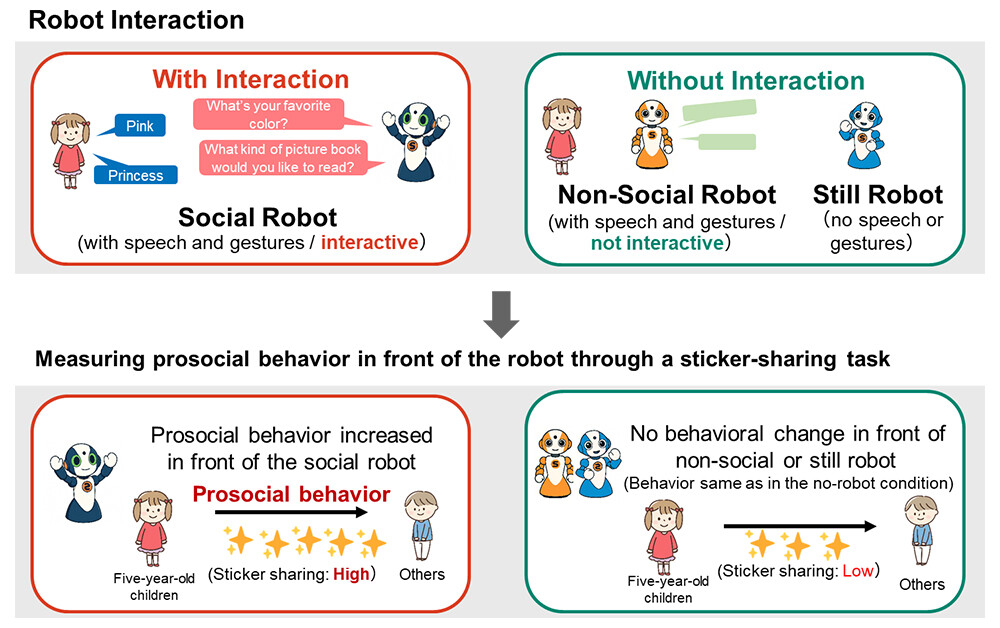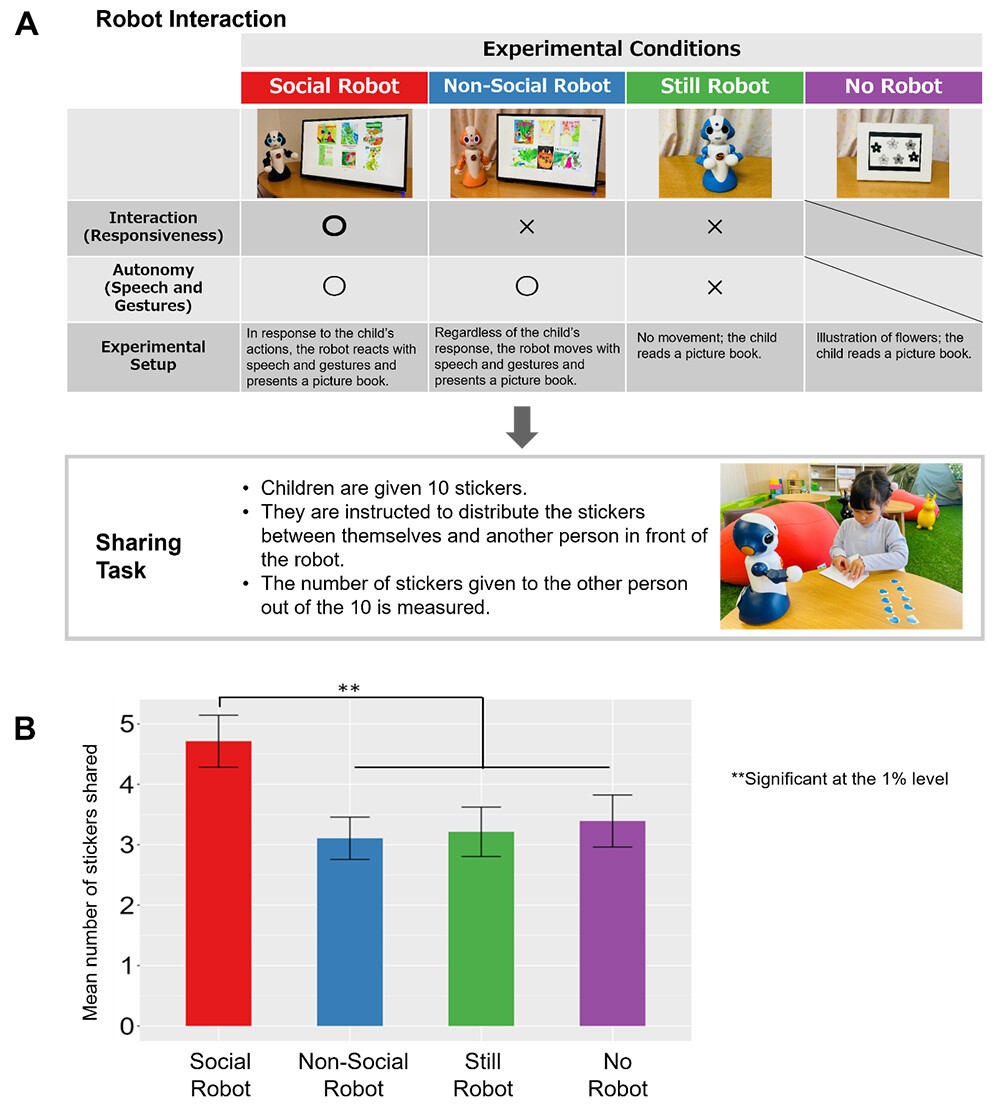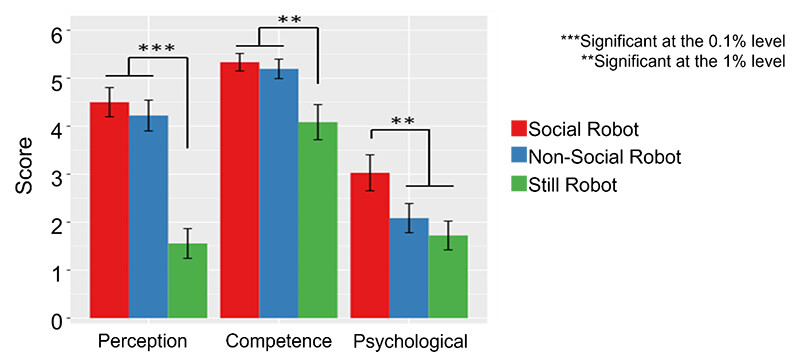Microsoft ends support for Internet Explorer on June 16, 2022.
We recommend using one of the browsers listed below.
- Microsoft Edge(Latest version)
- Mozilla Firefox(Latest version)
- Google Chrome(Latest version)
- Apple Safari(Latest version)
Please contact your browser provider for download and installation instructions.
May 13, 2025
NTT Corporation
Interaction with Robots Found to Promote Prosocial Behavior in Five-Year-Olds
Toward the development of learning companion robots to support early childhood education
News Highlights:
- The study demonstrated that five-year-old children exhibit prosocial behavior in front of a social robot after experiencing interactions involving speech and gestures with that robot.
- The findings suggest that through interaction, children may come to perceive the interactive social robot as having a mind.
- These results provide guidance for utilizing robots as learning companions to support children's education, contributing to the development of new approaches in early childhood education through AI.
TOKYO - May 13, 2025 - NTT Corporation (Headquarters: Chiyoda, Tokyo; President and CEO: Akira Shimada; hereinafter "NTT") has demonstrated, using experimental psychology method1, that interaction experiences with social robots can influence prosocial behavior in five-year-old children (Figure 1).
This study found that five-year-old children—an age at which strategic sociality begins to develop [1]—exhibited increased prosocial behavior in front of a social robot capable of interaction through speech and gestures. It was also revealed that such interactive social robots were perceived as having a mind compared to non-interactive robots.
These findings provide valuable guidance for the use of robots as learning companions to support children's education, offering important insights into the future of early childhood education.
This research will be showcased at the Open House 2025 of the NTT Communication Science Laboratories, held from May 20, 2025.
 Figure 1 Overview of the Findings
Figure 1 Overview of the Findings
Note. When five-year-old children experience interaction with a social robot capable of speech and gestures, they tend to behave more prosocially in front of that robot. In contrast, non-social robots that do not support interaction and still robots do not influence the children's behavioral tendencies.
Background
In recent years, learning methods have become increasingly diverse, and educational approaches utilizing AI and robots have garnered growing attention. As opportunities for children to acquire knowledge and skills from robots continue to increase, it is expected that in the near future, robots will play a more active role in everyday life as learning companions that support children's education.
As technological advances bring robots closer to daily life, understanding how children perceive and accept robots has become essential from the perspective of applying these technologies in early childhood education. Such insights can inform the design of educational programs that incorporate robots and ultimately contribute to improving early childhood education.
This study focused on how children perceive robots and explored their responses accordingly.
It is well known that as children grow, they acquire a range of social skills, beginning with empathy for others. This research focused on strategic sociality, which begins to develop around the age of five [1], and used experimental psychology methods to examine how interaction with robots may influence this development.
Research Findings
(1) The impact of interaction with robots on children's prosocial behavior
By around the age of five, children become sensitive to being observed and often try to present themselves in a positive light when they know someone is watching. For example, they tend to share more with others or refrain from dishonest behavior in front of observers. However, it has remained unclear how children behave when the observer is a robot. This study examined whether five-year-olds demonstrate prosocial behavior in front of a robot and how prior interaction with the robot may influence their actions (Figure 1).
In the experiment, children first had a face-to-face encounter with a robot (Figure 2A). In the social robot condition, children interacted with a robot capable of speech and gestures. In contrast, in the non-social robot condition, children faced with a robot that only replayed pre-programmed speech and movements periodically. In the still robot condition, children were presented with a non-moving robot. Additionally, the no-robot condition was included, in which no observer was present.
To measure prosocial behavior, a sticker-sharing task was conducted. In this task, each child received 10 stickers and was asked to divide them between themselves and another person while in front of the robot.
The results showed that five-year-old children who had interacted with a social robot shared more stickers with others in front of that robot (Figure 2B). In contrast, no such increase in prosocial behavior was observed in front of non-social or still robots, with children showing similar sharing behavior to when no robot was present. These findings suggest that social interaction with robots can promote prosocial behavior in five-year-old children.
 Figure 2 Experimental Procedure and Results
Figure 2 Experimental Procedure and Results
Note. (A) A total of 112 five-year-old children participated in one of four conditions (28 children per condition). Each child had a face-to-face encounter with a robot and then completed a sticker-sharing task. (B) Results of the sticker-sharing task. Children tended to share more stickers with others when in front of the social robot.
(2) Impressions robots make on children
To clarify which characteristics of robots influence children's behavior, we investigated how children perceive different types of robots. After facing with a social robot, a non-social robot, or a still robot, five-year-old children were asked about three characteristics: perception ("Does the robot see things?"), competence ("Is the robot smart?"), and psychological ("Does the robot feel happy or sad?"). For each question, children responded using a seven-point scale ranging from "strongly agree" to "strongly disagree."
The results showed that for perception and competence, children gave high ratings to both the social and non-social robots, with no significant differences between the two. However, for the psychological attribute, children rated the social robot significantly higher than the non-social or still robots (Figure 3). This indicates that through interaction, children may begin to perceive robots as beings with feelings such as happiness and sadness.
 Figure 3 Comparison of Children's Impressions Based on Robot Functionality
Figure 3 Comparison of Children's Impressions Based on Robot Functionality
Note. Children perceived the social robot as having a "mind" more strongly than the non-social or still robots.
This study was published in Child Development, a leading international journal in the field of developmental psychology [2].
Future Developments
This study suggests that social robots may be effective as learning companions that support children's autonomous learning and can serve as a foundation for designing early childhood education that utilizes AI.
At NTT Communication Science Laboratories, we are engaged in both fundamental research to scientifically understand children's learning mechanisms, and applied research to develop educational support technologies using robots based on those insights. Currently, we are developing Pitarie Touch, an AI system that utilizes social robots to recommend picture books tailored to each child's preferences and developmental stage (Figure 4). We are also working on a system that enables children to share their impressions of picture books through spoken dialogue with a social robot, aiming to enhance children's reading activities through effective support technology.
Going forward, we will continue to explore the interactions between children and robots to deepen our understanding of how children learn, and to develop more effective, personalized learning support methods. Our goal is to realize learning companion robots that can truly support early childhood education.
 Figure 4 "Pitarie Touch" — A System That Recommends Picture Books Matching Children's Preferences, Guided by a Robot
Figure 4 "Pitarie Touch" — A System That Recommends Picture Books Matching Children's Preferences, Guided by a Robot
https://www.rd.ntt/e/cs/team_project/icl/cd/research_innovative10.html
[Glossary]
1Experimental psychological method: An experimental approach that investigates how specific factors influence behavior by setting up and comparing different conditions.
[Reference]
[1]S. Grueneisen, F. Warneken (2022). The development of prosocial behavior: From sympathy to strategy. Current Opinion in Psychology, Vol. 43, pp. 323-328. https://doi.org/10.1016/j.copsyc.2021.08.005
[2]Y. Okumura, T. Hattori, S. Fujita, T. Kobayashi (2023). A robot is watching me!: Five-year-old children care about their reputation after interaction with a social robot. Child Development, Vol. 94, pp. 865-873. https://doi.org/10.1111/cdev.13903
About NTT
NTT contributes to a sustainable society through the power of innovation. We are a leading global technology company providing services to consumers and businesses as a mobile operator, infrastructure, networks, applications, and consulting provider. Our offerings include digital business consulting, managed application services, workplace and cloud solutions, data center and edge computing, all supported by our deep global industry expertise. We are over $92B in revenue and 330,000 employees, with $3.6B in annual R&D investments. Our operations span across 80+ countries and regions, allowing us to serve clients in over 190 of them. We serve over 75% of Fortune Global 100 companies, thousands of other enterprise and government clients and millions of consumers.
Media contact
NTT Science and Core Technology Laboratory Group
Public Relations
Inquiry Form
Information is current as of the date of issue of the individual press release.
Please be advised that information may be outdated after that point.
NTT STORY
WEB media that thinks about the future with NTT










